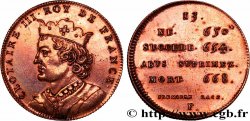E-auction 641-646366 - SÉRIE MÉTALLIQUE DES ROIS DE FRANCE Règne de HUGUES CAPET - 35 - refrappe ultra-moderne
Sie müssen angeschlossen sein und von cgb.fr genehmigt werden, um in einer E-Auktion teilzunehmen.Melden Sie sich an, um zu wetten..Die Kontobestätigungen sind innerhalb von 48 Stunden nach Ihrer Anmeldung gemacht.Warten Sie nicht bis die letzten zwei Tage vor dem Abschluss eines Verkaufs, um Ihre Registrierung abzuschließen. Klickend "BIETEN" verpflichten Sie sich vertraglich, diesen Artikel zu kaufen und Sie nehmen ohne Reserve die allgemeinen Verkaufsbedingungen für den e-auctions zu cgb.fr an.
Der Verkauf wird an der Zeit auf der Übersichtsseite angezeigt geschlossen werden. Angebote, die nach der Schließung Zeit empfangen sind, werden nicht gültig.
Bitte beachten Sie, dass die Fristen für die Einreichung Ihres Angebots auf unsere Server können variieren und es kann zur Ablehnung Ihres Angebots entstehen, wenn es in den letzten Sekunden des Verkaufs gesendet wird. Die Angebote sollen mit ganzer Zahl ausgeführt sein, Sie können Kommas oder des Punktes in Ihrem Angebot nicht erfassen. Bei Fragen klicken Sie hier, um einen Blick auf die FAQ E-Auktionen.
KEINE ANSCHAFFUNGSKOSTEN FÜR DIE KÄUFER.
KEINE ANSCHAFFUNGSKOSTEN FÜR DIE KÄUFER.
2025/07/28 20:32:00
fme_1025453
641
Sie müssen sich anmelden, um zu bieten
Klicken Sie hier, um sich anzumelden
Type : Règne de HUGUES CAPET - 35 - refrappe ultra-moderne
Datum: n.d.
Metall : vergoldete Bronze
Durchmesser : 32 mm
Stempelstellung : 12 h.
Gewicht : 21,43 g.
Rand cannelée
Punze : corne d’abondance
Kommentare zum Erhaltungszustand:
Patine hétérogène avec des traces de manipulation et traces de rayures
Vorderseite
Titulatur der Vorderseite HUGUES CAPET ROY DE FRANCE.
Beschreibung Vorderseite Buste imaginaire couronné et drapé à droite.
Rückseite
Titulatur der Rückseite 35. / NÉ. 941*. / COURONNÉ. 987. / RETABLISSEMENT DE LA / DISCIPLINE ECCLESIASTIQUE. / MORT 996. / COMMENCEMENT DE LA / TROISIEME RACE. / P..
Beschreibung Rückseite Légende en 9 lignes et corne d’abondance à l’exergue.
Kommentare
Médaille conservée sous capsule
Hugues Capet (né vers 940, mort au lieu-dit « Les Juifs », près de Prasville (Eure-et-Loir) le 24 octobre 996), duc des Francs (960-987), puis roi des Francs (987-996), fut le premier souverain de la dynastie capétienne. Fils de Hugues le Grand et de son épouse Hedwige de Saxe, il est l'héritier des puissants Robertiens, la lignée qui est en compétition pour le pouvoir avec la dynastie carolingienne et les grandes familles aristocratiques de Francie aux IXe et Xe siècles.
La fin du Xe siècle connaît le début d'une révolution économique et sociale qui allait trouver son apogée vers 1100 Les progrès agricoles, le début des défrichements et l'augmentation des capacités d'échanges entraînée par l'introduction du denier d'argent par les premiers Carolingiens, entraînent une dynamique économique encore timide mais réelle. Dans le même temps, la fin des invasions et la continuité des guerres personnelles entraînent la construction des premiers châteaux privés où peuvent trouver refuge les paysans. En parallèle, la nouvelle élite guerrière, les chevaliers, entre en concurrence avec l'ancienne aristocratie foncière carolingienne. Pour canaliser ces nouveaux venus et pour assurer la protection de leurs biens, l'aristocratie et l'Église soutiennent et exploitent le mouvement de la paix de Dieu. C'est dans ce contexte qu'Hugues Capet peut instaurer la dynastie capétienne.
Pour la suite de la biographie, voir http://fr.wikipedia.org/wiki/Hugues_Capet.
Medal preserved under capsule Hugues Capet (born around 940, died at the place called “Les Juifs”, near Prasville (Eure-et-Loir) on October 24, 996), Duke of the Franks (960-987), then King of the Franks (987-996), was the first sovereign of the Capetian dynasty. Son of Hugh the Great and his wife Hedwig of Saxony, he is the heir to the powerful Robertians, the line that competed for power with the Carolingian dynasty and the great aristocratic families of Francia in the 9th and 10th centuries..
The end of the 10th century saw the beginning of an economic and social revolution which would reach its peak around 1100. Agricultural progress, the beginning of land clearing and the increase in trading capacity brought about by the introduction of the silver denarius by the first Carolingians, led to an economic dynamic which was still timid but real.. At the same time, the end of invasions and the continuation of personal wars led to the construction of the first private castles where peasants could find refuge.. At the same time, the new warrior elite, the knights, entered into competition with the old Carolingian landed aristocracy.. To channel these newcomers and to ensure the protection of their property, the aristocracy and the Church supported and exploited the Peace of God movement.. It is in this context that Hugh Capet can establish the Capetian dynasty.
For the rest of the biography, see http://fr. Wikipedia. org/wiki/Hugues_Capet
Hugues Capet (né vers 940, mort au lieu-dit « Les Juifs », près de Prasville (Eure-et-Loir) le 24 octobre 996), duc des Francs (960-987), puis roi des Francs (987-996), fut le premier souverain de la dynastie capétienne. Fils de Hugues le Grand et de son épouse Hedwige de Saxe, il est l'héritier des puissants Robertiens, la lignée qui est en compétition pour le pouvoir avec la dynastie carolingienne et les grandes familles aristocratiques de Francie aux IXe et Xe siècles.
La fin du Xe siècle connaît le début d'une révolution économique et sociale qui allait trouver son apogée vers 1100 Les progrès agricoles, le début des défrichements et l'augmentation des capacités d'échanges entraînée par l'introduction du denier d'argent par les premiers Carolingiens, entraînent une dynamique économique encore timide mais réelle. Dans le même temps, la fin des invasions et la continuité des guerres personnelles entraînent la construction des premiers châteaux privés où peuvent trouver refuge les paysans. En parallèle, la nouvelle élite guerrière, les chevaliers, entre en concurrence avec l'ancienne aristocratie foncière carolingienne. Pour canaliser ces nouveaux venus et pour assurer la protection de leurs biens, l'aristocratie et l'Église soutiennent et exploitent le mouvement de la paix de Dieu. C'est dans ce contexte qu'Hugues Capet peut instaurer la dynastie capétienne.
Pour la suite de la biographie, voir http://fr.wikipedia.org/wiki/Hugues_Capet.
Medal preserved under capsule Hugues Capet (born around 940, died at the place called “Les Juifs”, near Prasville (Eure-et-Loir) on October 24, 996), Duke of the Franks (960-987), then King of the Franks (987-996), was the first sovereign of the Capetian dynasty. Son of Hugh the Great and his wife Hedwig of Saxony, he is the heir to the powerful Robertians, the line that competed for power with the Carolingian dynasty and the great aristocratic families of Francia in the 9th and 10th centuries..
The end of the 10th century saw the beginning of an economic and social revolution which would reach its peak around 1100. Agricultural progress, the beginning of land clearing and the increase in trading capacity brought about by the introduction of the silver denarius by the first Carolingians, led to an economic dynamic which was still timid but real.. At the same time, the end of invasions and the continuation of personal wars led to the construction of the first private castles where peasants could find refuge.. At the same time, the new warrior elite, the knights, entered into competition with the old Carolingian landed aristocracy.. To channel these newcomers and to ensure the protection of their property, the aristocracy and the Church supported and exploited the Peace of God movement.. It is in this context that Hugh Capet can establish the Capetian dynasty.
For the rest of the biography, see http://fr. Wikipedia. org/wiki/Hugues_Capet








 Berichten über einen Fehler
Berichten über einen Fehler Die Seite drucken
Die Seite drucken Teilen meiner Auswahl
Teilen meiner Auswahl Stellen Sie eine Frage
Stellen Sie eine Frage Einlieferung/Verkauf
Einlieferung/Verkauf
 Details
Details










